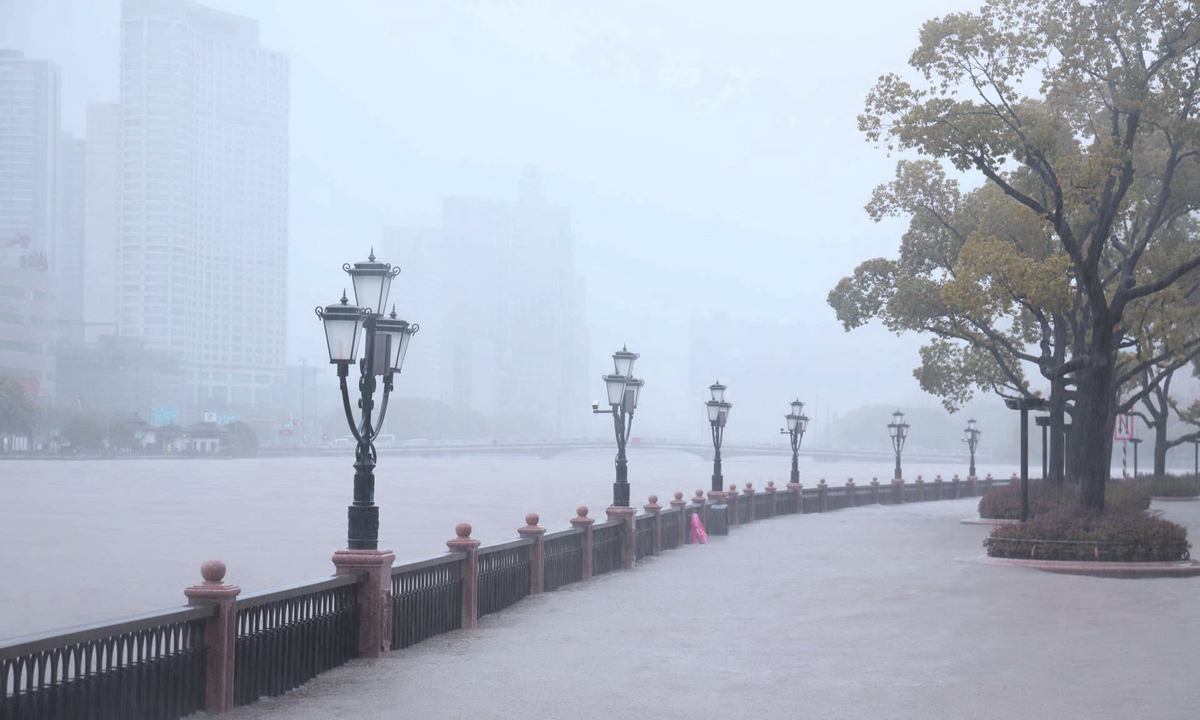
A walk in Ningbo, East China's Zhejiang province, is flooded by river water on September 14, 2022 as Typhoon Muifa hits the city. Photo: IC
Transportation and classes were suspended and more than 1 million people in Shanghai and other cities of East China's Zhejiang Province were evacuated on Wednesday as the country moved to its highest tropical cyclone alert level for Typhoon Muifa, the strongest typhoon to land in China so far in 2022.
The storm is expected to hit 12 provinces and cities with severe gales and rainstorms.
Experts warned of potential damage and disasters brought by Muifa due to the long time and large range of its influence, but noted that it can also relieve the severe drought that some regions along the Yangtze River have suffered because of the continuous high temperatures.
China's National Meteorological Center (NMC) on Wednesday morning issued the first red alert for a typhoon in 2022 as Typhoon Muifa approached East China.
Around 8:30 pm on Wednesday, Muifa landed in the coastal regions of Zhoushan in Zhejiang Province, with the maximum winds near the center being 42 meters per second, and the minimum pressure at the center being 960 HPA, which makes it the strongest typhoon to land in China so far this year.
It is expected to make a second landfall along the coast from Pinghu in Zhejiang to Pudong in Shanghai around Wednesday midnight.
Gales and rainstorms are expected to affect the East China region for at least three days and further move toward Northeast China. A total of 12 provinces and regions are expected to be affected. Cumulative rainfall in some areas is expected to reach 50 millimeters to 150 millimeters between Wednesday and Friday, with some parts hitting 350 millimeters or more.
Experts reminded that the strong power of Muifa could unleash torrential rain and the potential for damaging winds, as well as a disruptive ocean surge, suggesting that affected regions such as Zhejiang, Shanghai and Jiangsu should prevent the adverse effects of strong wind and rainstorms on urban operations, transportation, fisheries and offshore aquaculture facilities, as well as epidemic prevention and control.
The typhoon is also expected to relieve the recent severe drought in the middle and lower reaches of the Yangtze River that resulted from continuous high temperatures, and will benefit the storage of water in reservoirs and agricultural irrigation, Dong Lin, chief forecaster of the NMC, told the Global Times on Wednesday.
As of 9 pm, about 395,000 people in Shanghai had been relocated. The city's flood control headquarters raised the emergency response to level II at 4 pm. Nearly 838,000 people had been relocated in Zhejiang as of 10 am on Wednesday, according to media reports.
Ports along the coast of Zhejiang and Shanghai have been fully mobilized and contingency measures, such as shutting down dock yards, have been put in place. Multiple waterways in Ningbo city, Zhejiang and Shanghai, as well as train lines in the Yangtze River Delta region, were also suspended.
Influenced by Muifa, the airports in Ningbo, Zhoushan and Taizhou cities in Zhejiang canceled all flights on Wednesday, while all the passenger flights arriving at or departing from Shanghai's Pudong International Airport and Hongqiao International Airport were canceled after 5:30 pm on Wednesday.
Some cities in Zhejiang, such as Jiaxing and Shaoxing, suspended classes on Wednesday.
Ningbo in Zhejiang has decided to suspend the requirement of 72-hour normalized nucleic acid testing within the city until the typhoon emergency response is over, except for gateways to the city such as airports, railway stations, highway check points and service zones.
The State Flood Control and Drought Relief Headquarters raised the emergency response for flood and typhoon control to level III on Tuesday at noon and made arrangements for defense against the typhoon, while the China Meteorological Administration jointly issued a red alert for floods and a warning of geological hazards, along with the Ministry of Water Resources and the Ministry of Natural Resources.




